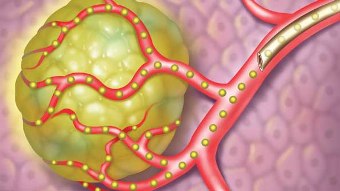
 Uterine fibroid embolisation (UFE), also known as uterine artery embolisation, is performed by an interventional radiologist, a physician who is trained to perform this and other types of embolization and minimally invasive procedures. The procedure is performed while the patient is conscious”but sedated and feeling no pain. It does not require general anesthesia and usually only a hospital stay of one night. Painkilling medications and drugs that control swelling are prescribed following the procedure.
Uterine fibroid embolisation (UFE), also known as uterine artery embolisation, is performed by an interventional radiologist, a physician who is trained to perform this and other types of embolization and minimally invasive procedures. The procedure is performed while the patient is conscious”but sedated and feeling no pain. It does not require general anesthesia and usually only a hospital stay of one night. Painkilling medications and drugs that control swelling are prescribed following the procedure.
According to the AmericanCollege of Obstetricians and Gynecologists, UFE is safe and effective. Women can and should be confident about their decision to consider UFE as a treatment option. An ultrasound or MRI diagnostic test will help an interventional radiologist to determine if a woman is a candidate.
Interventional radiology is a recognized medical specialty by the American Board of Medical Specialties. Interventional radiologists complete preliminary training in diagnostic radiology and advanced training in vascular and interventional radiology.

According to the Society of Interventional Radiology, 20 to 40 percent of women, age 35 and older, have uterine fibroids of a significant size. Learning more about these common, benign growths”and how they affect womens health”can be a smart idea.
Uterine fibroids develop in the muscular wall of the uterus, ranging in size from a quarter of an inch to larger than a cantaloupe. Occasionally, they can cause the uterus to grow to the size of a five-month pregnancy. Uterine fibroids are the most frequent indication for hysterectomy in premenopausal women.


Be a part of Elets Collaborative Initiatives. Join Us for Upcoming Events and explore business opportunities. Like us on Facebook , connect with us on LinkedIn and follow us on Twitter , Instagram.
"Exciting news! Elets technomedia is now on WhatsApp Channels Subscribe today by clicking the link and stay updated with the latest insights!" Click here!
















